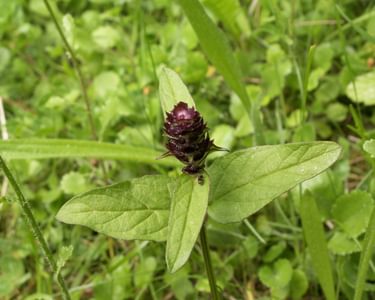Selfheal

Other names
heal all, touch and heal
Latin names
Prunella vulgaris L.
Weed Type
Perennial Broad-leaved Weeds
Where would I find Selfheal?
Selfheal is a native perennial found in grassland, lawns, wood clearings, field margins and rough ground. It is abundant in grassy places except the most acid. It is sometimes an aggressive weed in short or open turf. Selfheal is common throughout Britain and is recorded up to 2,480 ft. Selfheal has some tolerance of shade but prefers a vegetation cover reduced by grazing or cutting.
Selfheal is morphologically plastic and the growth habit is affected by grazing intensity and by climate. In lawns it has a prostrate habit, elsewhere it forms a loose clump. Some plants produce only flowering stems, a few plants have just vegetative shoots and others have a mixture of the two. This character is under genetic control. In Europe, annual and perennial races occur.
Selfheal is used medicinally as a mouthwash and gargle for throat infections.
Biology
Selfheal flowers from June to November. The flowers are self-sterile and insect pollinated. Seeds are shed from August to October. There are around 80 seeds per flower spike. The mean number per plant is 850.
The germination of selfheal seed is greater at alternating temperatures of 20 to 30°C than a constant 20°C. Seed germinates better in the light than in the dark. Germination is improved by scarification.
Seeds sown in a 75 mm layer of soil in the field and cultivated periodically emerged from February to October with peaks of emergence in April and September. Flushes tend to follow cultivations. Seedling emergence is greater in bare soil than in vegetation or leaf litter covered soil.
Shoots generally die after flowering but may regenerate from the base. Selfheal overwinters as a rosette of leaves. The new shoots elongate in late spring.
Does Selfheal spread easily?
Seeds can persist for at least 5 years in cultivated soil. Seeds have been recorded in large numbers in the soil beneath pasture even when the plant was poorly represented in the vegetation cover.
Selfheal spreads by seed. The seed was a common impurity of clover and cultivated grass seed of UK, Swedish and Danish origin.
Selfheal also spreads vegetatively by short rhizomes or stolons. It regenerates from shoot fragments if the plant is disturbed and is able to rapidly colonise cleared areas.
How to manage Selfheal organically
Selfheal is not usually a problem on cultivated land.
Selfheal is often abundant in short turf where it forms large patches. In longer grass it is dominated by the taller plants. On poor land where selfheal occurs in leys and temporary pasture, control measures include a good dressing of lime. Grazing with sheep will reduce it, as will sowing clover into an infested pasture. Mowing and trampling encourages prostrate growth with the creeping stems rooting at the nodes when they touch the ground. Selfheal tolerates rabbit grazing and flourishes where the vegetation is heavily grazed by rabbits.